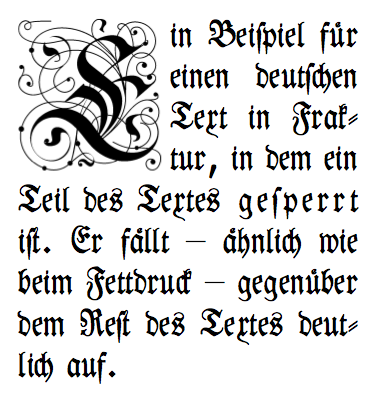Fraktur: Difference between revisions
Montrealais (talk | contribs) No edit summary |
destubbing; will replace image later |
||
| Line 1: | Line 1: | ||
[[de:Fraktur]] |
[[de:Fraktur]] |
||
'''Fraktur''' |
The [[German language|German]] word '''Fraktur''' refers to a family of [[typeface]]s. The term derives from the past [[participle]] of [[Latin]] ''frangere'' ("to break"). The antonym is [[Antiqua]]; as opposed to those typefaces, Fraktur letters are more broken up, approximating handwriting. |
||
<div style="float:right;margin:5px;border:1px;border-style:solid">[[Image:Emphasis_typography2.png]]</div> |
|||
Examples: |
|||
In a more narrow sense, the term "Fraktur" refers to typefaces used in the [[Middle Ages]] and later ones resembling those. As opposed to other countries, in Germany, typesetting in Fraktur was entirely common still in the [[19th century]]. It went out of fashion during the early [[20th century]] because of the obvious communication problems with non-native German speakers. However, in an attempt to deliberately differentiate Germany from the rest of the Western world, it was reinforced by [[Nazi Germany]] ([[1933]]-[[1945]]) and held up until [[1941]], when it became clear that its use would inhibit communication in the territories occupied during [[World War II]] also. |
|||
Today, Fraktur is merely used for decorative typesetting any more; for example, a number of German newspapers still print their name in Fraktur on the first page. Isolated Fraktur letters are also used in [[mathematics]]. |
|||
<math> |
|||
\begin{matrix} |
|||
\mathfrak{abcdefghijklmnopqrstuvwxyz} \\ |
|||
\mathfrak{ABCDEFGHIJKLMNOPQRSTUVWXYZ} |
|||
\end{matrix} |
|||
</math> |
|||
== Related articles == |
|||
:''Note: this is a [[stub article]]'' |
|||
| ⚫ | |||
* [[Emphasis (typography)]] |
|||
| ⚫ | |||
== External links == |
== External links == |
||
Revision as of 01:03, 2 May 2003
The German word Fraktur refers to a family of typefaces. The term derives from the past participle of Latin frangere ("to break"). The antonym is Antiqua; as opposed to those typefaces, Fraktur letters are more broken up, approximating handwriting.
In a more narrow sense, the term "Fraktur" refers to typefaces used in the Middle Ages and later ones resembling those. As opposed to other countries, in Germany, typesetting in Fraktur was entirely common still in the 19th century. It went out of fashion during the early 20th century because of the obvious communication problems with non-native German speakers. However, in an attempt to deliberately differentiate Germany from the rest of the Western world, it was reinforced by Nazi Germany (1933-1945) and held up until 1941, when it became clear that its use would inhibit communication in the territories occupied during World War II also.
Today, Fraktur is merely used for decorative typesetting any more; for example, a number of German newspapers still print their name in Fraktur on the first page. Isolated Fraktur letters are also used in mathematics.

